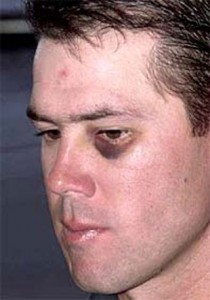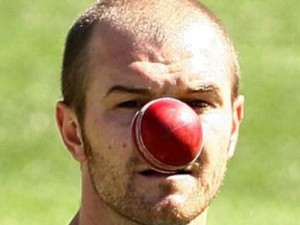
A gradual but inevitable descent into cricket-based loathing and bile.
Whatever Happened To The Unlikely Lads (International Edition)? #15: Jason Krejza
All the stories that you hear about the banter that goes on in the typical cricket changing room leads us to believe it must be a pretty shocking place. Hanging around a bunch of other men with questionable personal hygiene, shocking facial hair and a vocabulary that doesn’t extend far beyond the game itself doesn’t sound all that appealing to us. And that’s not to even consider the hilarious practical jokes, like coming in for the tea interval to find some bastard has tried to flush half your kit down the dunny. Hilarious. So it’s no surprise to hear of players falling out because they never really fitted into the dressing room atmosphere. Frankly we’re surprised it doesn’t happen more often. There is one player, though, who we imagine stuck out in the Australian dressing room like the designated driver at the 51allout Christmas party; a player whose background meant he was probably not all that inclined to discuss the finer aspects of huntin’, fishin’ and drinkin’ that comprises the stock in trade of your typical Aussie cricketer. We talk of:
#15: Jason John Krejza
Having a nickname like ‘crazy’ is probably a good indication that Krejza was always going to be something of a misfit. In truth he probably never really stood a chance. Growing up in the inner-city Sydney suburb of Newtown, famous for its second-hand bookstores, Thai restaurants and lesbian bars, isn’t really the typical upbringing for an Australian cricketer, who probably think feminism is something you try out in the bedroom with the missus after one too many Bundy and Cokes. Off spinners have a reputation for being a little ‘odd’ at the best of times, and with Krejza’s penchant for reading books with more words than pictures, we imagine most of the Australian dressing room considered him to be no exception to that particular rule.
Krejza followed the now well-trodden road towards the Test team by fleeing to Tasmania after not being able to force his way into the New South Wales team. His arrival in the Apple Isle didn’t begin auspiciously, after a poor first season and being nabbed for drink driving by the Hobart police. However he proceeded to knuckle down and proved that not only was he not afraid of giving the ball some flight, he was also capable of generating some alarming turn and bounce. He soon earned a reputation of being a dangerously erratic spin bowler, one as likely to offer up a rank long hop as to spin one a mile out of the rough. His figures were, frankly, pretty crap, garnering 18 wickets at near to 50 runs apiece in the 2007/8 domestic season, but the selectors obviously saw something promising in the enigmatic offie.
The 2008 Australian tour of India was something of a landmark occasion. After finally breaking its subcontinent hoodoo in 2004, the 2008 version served to show up the deficiencies within the squad that make the Australian Test side the lovable bunch of losers we’ve all come to know these days. The front-line spinner for the tour was, believe it or not, Bryce McGain. Yes, that Bryce McGain. After he withdrew from the tour through injury (or possibly just rubbishness), Krejza was called up as his replacement. After a stunning performance in a tour game against an Indian Board President’s XI, where he took 0/199 in 31 memorable overs, the other renowned spinner in the squad, Cameron White (yes, that Cameron White), got the nod as Australia’s main spinner for the first three Tests.
Amazingly enough, Australia went into the fourth and final Test only 1-0 down. The Indians were having a field day against White, who had taken just five wickets at an average of 60 so far. Clearly, in order to win the final Test, something had to change. And so, to the barely concealed horror of the entire Australian nation, in came Krejza. At this stage everybody was expecting fireworks, but even then we were hopelessly unprepared for what was to come when Krejza was thrown the ball for the first time. Krejza had the honour of claiming two world records in that first innings. The eight wickets he took in the first innings were the joint most by any bowler on début in Test history, while on the other hand, the 215 runs he conceded were likewise the most conceded in a bowler’s first innings. He followed that effort up with a further four wickets in the second innings, leaving him with the final tally of 12/358, as Australia went down by 172 runs.
Unfortunately, Krejza’s efforts were not enough for him to also claim the record for most runs conceded in a single Test, and the 9/374 Tommy Scott accumulated bowling for the West Indies against England in 1930 will stand a little while longer yet. What is remarkable though is that instead of earning most of his wickets through mishit slogs finding the fielders in the deep, as you would expect with figures like those, nearly all of Krejza’s wickets came near the bat, as he bamboozled the Indian batsmen for turn and bounce. His first Test dismissal, where he had Rahul Dravid caught at bat pad pushing forward to a top spinner, is as classic a spinner’s wicket that you could find.
Nobody really knew what to make of the performance. You couldn’t exactly drop a player who had taken 12 wickets on debut (Cameron White was shafted instead), but his lack of control threatened to make him a liability. In any case, Australia soon had their answer, as the next visitor to their shores were the South Africans, fresh from a victorious tour of England. It’s fair to say that when you haven’t been beaten in a home series for over 15 years, a degree of hubris can be expected, and so nobody really gave the tourists a chance to run down 414 in their second innings of the first Test, especially after they had been rolled for 281 in their first (where Krejza took a lone wicket).
English readers could perhaps sympathise with what then unfolded, with South Africa easing to the required total with the loss of only 4 wickets. Krejza, who was expected to spearhead the attack on the fifth day pitch, bowled 24-2-102-0, giving him match figures of 1/204, and the brunt of the blame for the loss. The wholly justified criticism directed at Krejza was that his lack of control effectively dissipated any pressure built up at the other end, allowing the South African batsmen to steadily accumulate runs throughout their innings. In Krejza’s defence, the typically defensive fields that Ponting set for him hardly did him any favours, and certainly didn’t play to his strengths. In any case the damage had been done, and the Australian selectors decided to look elsewhere for their front-line spinner, eventually going back to Bryce McGain. With hilarious results.
Krejza’s international career virtually ended that day. You may remember him taking part in last year’s ODI World Cup, but you would be excused if you don’t because he contributed bugger all throughout. He has since been jettisoned entirely, and whilst he continues to perform admirably on occasion for Tasmania, and probably wouldn’t be a bad option in the Australian T20 squad, a return to the international setup looks about as likely as Peter Siddle wining a Nobel Peace Prize. It’s easy to imagine that if Krejza had just been able to integrate into the dressing room a little better his international career would not have been terminated so hastily. It’s not as if the spinners who followed him covered themselves in glory.

Thankfully for him, Krejza did not play in the era of dressing room tickle fights, which were banned after one notoriously over-enthusiastic session in the late 90’s.
Krejza has since gone down the path of many current generation spinners, and attempted to curb his lack of control at the expense of the dangerous levels of turn that made him such a threat in the first place. He can now be found sending down a steady stream of top spinners without any real attempt at variation. Again, like his contemporaries he also seems set on converting himself into a genuine spinning all-rounder, which considering how well stocked Australia are in that department (Glen Maxwell is the current apple in the eye of the selectors while Steve Smith is the inevitable future), doesn’t seem to be a very well thought out career move.
All of which is a bit of a disappointment really, as the one thing Australia really could do with (aside from a new opening pair, fast bowlers who don’t fall apart, a new ‘keeper and a new team hairdresser) is someone who could provide genuine turn. It would have been interesting to see him perform under Michael Clarke’s attacking captaincy, rather than the turgid defensive fields Ponting typically set for him. Probably just as rubbish in truth, but at least a Clarke-led dressing room would have been more appreciative of his designer second-hand threads and bohemian (i.e. anything that doesn’t involve Jimmy Barnes) taste in music.


No Comments
Post a Comment